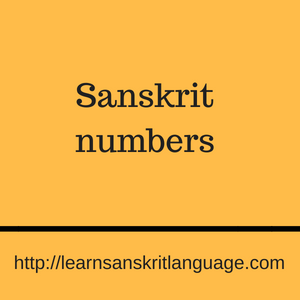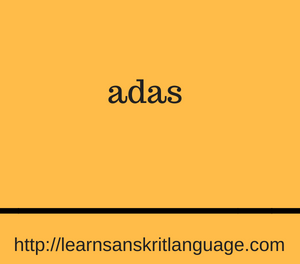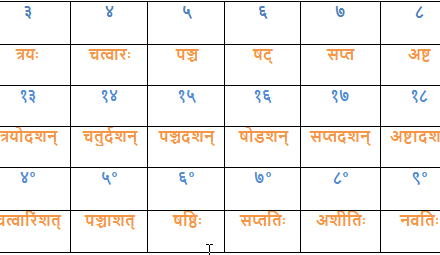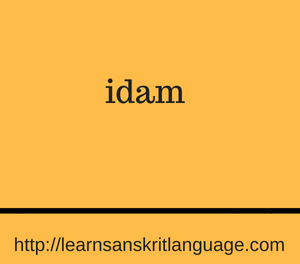Sanskrit numbers can be classified into 5 categories;
- eka
- dva
- tri and chatur
- pañcanto daśan (except for ṣaṣ)
- the rest of numbers
The first three appears in all the three genders, whereas the rest of them have no gender
- eka
eka is an inflicted number like a pronoun. It appears in the singular form only with all three genders.
- dva
dva is also an inflicted number but like a normal noun ending in a. it appears only in the dual form and its feminine form is dvā
- tri and chatur
These are the most irregular numbers. They both are plural, and both of them appear in all three genders.
chatur (masculine)
| इयम् | Plural |
|---|---|
| Case 1 (Subject) | चत्वारः catvāraḥ |
| Case 2 (object) | चतुरः caturaḥ |
| Case 3 (with) | चतुर्भिः caturbhiḥ |
| Case 4 (for) | चतुर्भ्यः caturbhyaḥ |
| Case 5 (from) | चतुर्भ्यः caturbhyaḥ |
| Case 6 (of) | चतुर्नाम् caturṇām |
| Case 7 (in) | चतुर्षु caturṣu |
In the neuter form, only the first two classes differ from masculine. These two cases have tri has trīni and chatur has catvāri.
In the feminine form, tri becomes tisṛ, and catur becomes catas. Both use noun endings for masculine and feminine consonants. In case 6 however, tisṛ is tisṛnām and catasṛ is catasṛnām. One thing to note is that the final r does not become long.
pañcanto daśan
| इयम् | Plural |
|---|---|
| Case 1 (Subject) | पञ्च pañca |
| Case 2 (object) | पञ्च pañca |
| Case 3 (with) | पञ्चभिः pañcabhiḥ |
| Case 4 (for) | पञ्चभ्यः pañcabhyaḥ |
| Case 5 (from) | पञ्चभ्यः pañcabhyaḥ |
| Case 6 (of) | पञ्चानाम् pañcānām |
| Case 7 (in) | पञ्चसु pañcasu |
These Sanskrit numbers have no genders but are inflicted like neuter nouns.
pañcan (no gender)
all of the numbers
- sas uses the regular consonant-stem endings
- asta (number 8) has some optional forms too. for instance, in case 1 it can be astau, in final a the stem can be ā
- The numbers from 11 to 99 are normally inflected words, though they have no genders, they can be used like feminine nouns. From 10 and above they are inflected normally, though they have no gender they can be used as neuter nouns.





